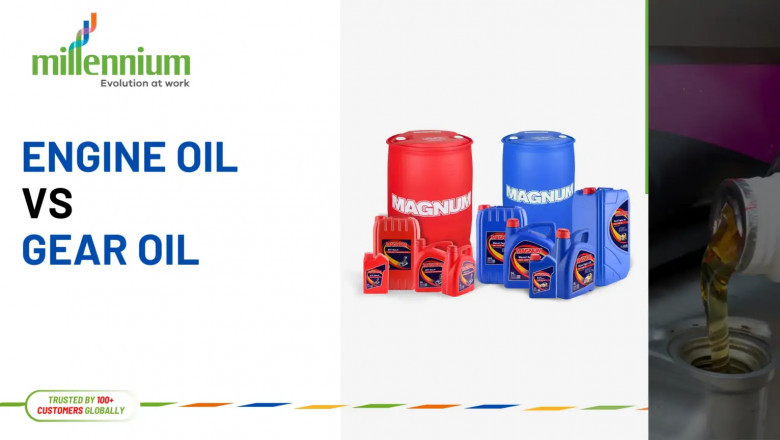views
Engine Oil Vs Gear Oil
Lubrication is critical to the smooth and efficient operation of vehicles and machinery. Two of the most essential lubricants in this space are engine oil and gear oil. While both serve the primary purpose of reducing friction and wear, they are formulated quite differently to meet the demands of their specific applications. Understanding the distinctions between the two is crucial for proper maintenance and ensuring the longevity of engines and gear systems.
What is Engine Oil?
Engine oil, also known as motor oil, is a lubricant used specifically in internal combustion engines. It is designed to reduce friction between the moving parts inside an engine, prevent overheating, and protect components from wear and corrosion.
Composition and Use in Engines
Engine oil typically consists of a base oil (mineral, synthetic, or semi-synthetic) and a range of additives that enhance performance. These additives include:
-
Detergents to clean internal components
-
Dispersants to suspend contaminants
-
Anti-wear agents like zinc dialkyldithiophosphate (ZDDP)
-
Viscosity index improvers to maintain fluidity across temperature ranges
-
Oxidation inhibitors to extend oil life
Engine oil must endure high-speed movement, combustion by-products, and rapid temperature fluctuations, often ranging from below freezing to over 200°C. It also plays a role in cooling the engine and sealing gaps between pistons and cylinder walls.
What is Gear Oil?
Gear oil is a high-viscosity lubricant specifically formulated for gearboxes, transmissions, and differentials. These components deal with heavy loads, slow-moving metal surfaces, and high-pressure contact between gear teeth.
Composition and Use in Gear Systems
Gear oil usually contains a thicker base oil and extreme pressure (EP) additives, such as sulfur-phosphorus compounds, which form a protective film on gear surfaces. This prevents metal-to-metal contact under high torque.
Common properties of gear oil include:
-
High viscosity to create a durable lubricating film
-
Additives for shock load protection
-
Anti-foaming agents for smooth gear operation
-
Resistance to oxidation and thermal breakdown
Gear oils are used in manual transmissions, differentials, transfer cases, and industrial gearboxes, where operating conditions involve high loads rather than high speeds.
Key Differences Between Engine Oil and Gear Oil
While both types of oil are vital for proper vehicle function, their formulations, applications, and characteristics differ significantly.
Viscosity Differences
One of the most noticeable differences between engine oil and gear oil is viscosity, or the oil’s resistance to flow.
-
Engine oil is generally thinner (lower viscosity) to allow for rapid circulation, especially during cold starts. Typical viscosities include SAE 5W-30 or 10W-40.
-
Gear oil is thicker (higher viscosity), with common ratings like SAE 75W-90 or 80W-140, designed to stay between the gears and maintain a protective layer under pressure.
It’s important to note that engine and gear oils follow different SAE grading systems, so a gear oil labeled 75W-90 is not thinner than a 10W-30 engine oil, even though the numbers might suggest otherwise.
Temperature Tolerance and Additives
-
Engine oil needs to handle wide temperature variations and clean the engine. It contains detergents, dispersants, and anti-oxidation additives.
-
Gear oil is built for stability under shear forces and high contact pressure. It uses EP additives like sulfur and phosphorus to prevent gear wear, which would be corrosive in engines.
These distinct additive packages make each type of oil unsuitable for the other’s application.
When to Use Engine Oil vs. Gear Oil
Choosing between engine oil and gear oil is straightforward when you understand the system’s design and lubrication needs:
-
Use engine oil for engines only. It is ideal for reducing friction in high-speed, high-temperature environments and for cleaning and cooling engine parts.
-
Use gear oil for transmissions, differentials, and gearboxes. Its high load-carrying capacity and resistance to extreme pressure make it the only suitable option for these systems.
Using the wrong oil can lead to severe mechanical damage. For example, using engine oil in a differential can cause the oil to shear down, fail to protect gears, and result in rapid wear. Conversely, using gear oil in an engine could cause sludge buildup, reduced oil flow, and overheating.
Conclusion
While engine oil and gear oil may seem similar, they are engineered for entirely different purposes. Understanding the differences in composition, viscosity, and performance characteristics is essential for proper equipment maintenance. Always refer to your vehicle or machinery’s manufacturer recommendations and avoid interchanging the two.
Selecting the right oil ensures optimal performance, extended equipment life, and reduced maintenance costs. Whether you're maintaining a car, truck, or industrial machine, using the correct lubricant is a small decision that makes a big impact.














Comments
0 comment